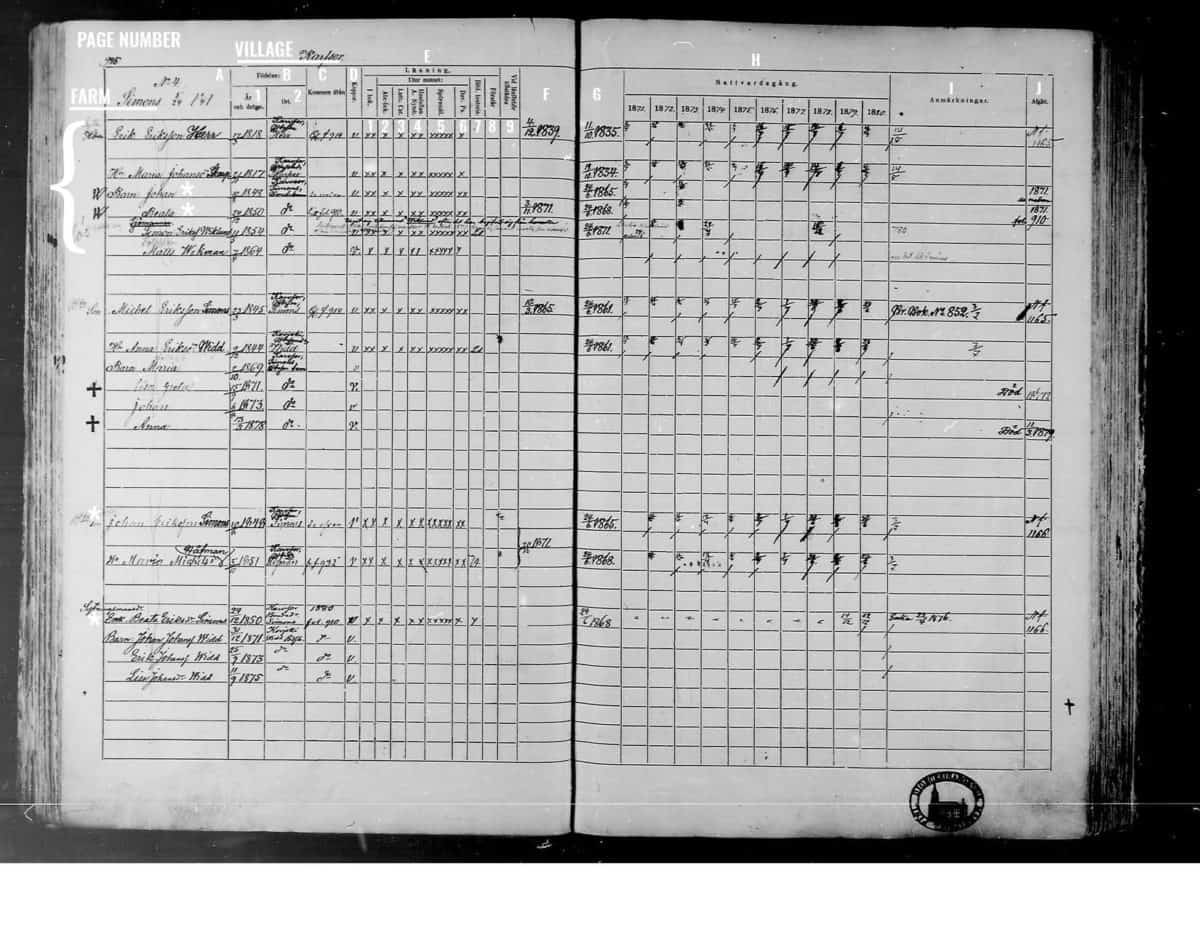 At first glance, communion records can be a mystery. However, they are filled with an enormous amount of information and it is worth the effort to learn how to read them. Armed with the following knowledge you will soon be an expert. Image provided by Finnish Family History Association.
At first glance, communion records can be a mystery. However, they are filled with an enormous amount of information and it is worth the effort to learn how to read them. Armed with the following knowledge you will soon be an expert. Image provided by Finnish Family History Association.
Parish Structure Every parish is comprised of villages. Some parishes have a few villages, some parishes have far more. Each village contains farms. Again, there may be a few or there may be dozens. Records for each farm can be several pages long. Not everyone on the farm is related. For example, there can be landowners, tenant farmers, farmhands, and maids all living on one farm. Our example is a page from the Simons farm in the village of Karfsor (also spelled Karvsor), located in the parish of Vörå.
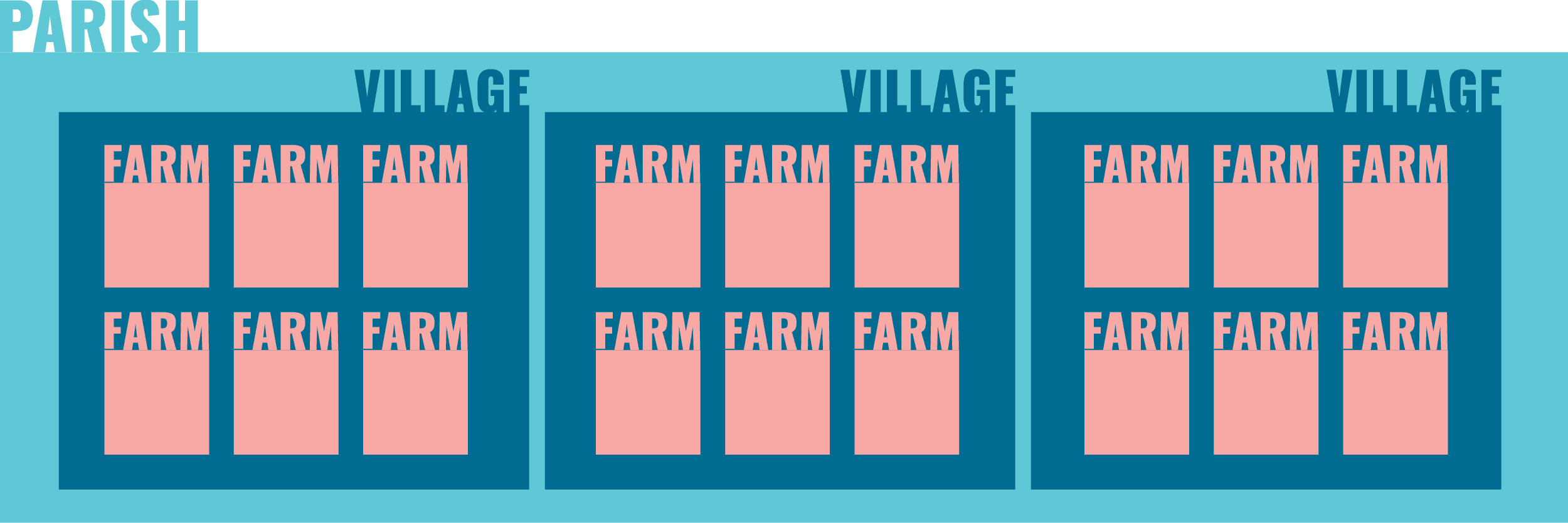
The Family—Column A In our example we have the following family members: Hb. Erik Eriksson Herr, hu. Maria Johansdotter Skarp. Barn: Johan, Beata, Sjömannen Simon Erikss. Wiklund, and Matts Wikman. Erik has the abbreviation Hb. before his name. This can mean head of household, landowner, or farmer. Maria also has an abbreviation, hu., before her name. This is an abbreviation of hustru which means wife. Barn is listed in front of Johan’s name. Barn means child or children. There are ditto marks in front of the remaining children’s names, so they are also the children of Erik and Maria. Some parishes mark the boys as s. or son and the girls with d., dtr., or dotter. Simon is noted with Sjömannen which means sailor or seaman. It is interesting that Simon has the last name Wiklund and Matts has the name Wikman. They are the children of Erik and Maria but have different surnames. Looking in further records might give us a clue as to why but keep in mind surnames were changed often in Finland until 1921. What we think of as surnames are not tied to a person but to a place or area. They are commonly referred to as farm names.
Another common practice to be aware of is moving a married child down the record sheet when they marry. In this example we see Johan and Beata (marked with asterisks) have their own families. Notice that Beata has Enk. in front of her name signifying that she is a widow. But who is Michel Eriksson Simons? We see that Son is written in faint writing in the margin. A quick check of the parish birth records confirms that Michel is the grown son of Erik and Maria. He is no longer listed under his parents because he already had his own family the year this communion book was started. If we look in the book before this one we will find him listed with his siblings under his parents. The left margin of the communion record contains a lot of valuable scribbles. None of them are meaningless. Erik is marked with the abbreviation Sytn. in very faint writing. This means that he is on a pension. There are marks beside Johan and Beata’s names that looks like a W. It is actually two marks similar to checkmarks very close together. These marks tell us that Johan and Beata have moved twice. Beside Johan’s name they have written Bondeson or farmer’s son. And finally beside Beata’s name they have written Sytningsmansdtr. which means pensioner’s daughter.
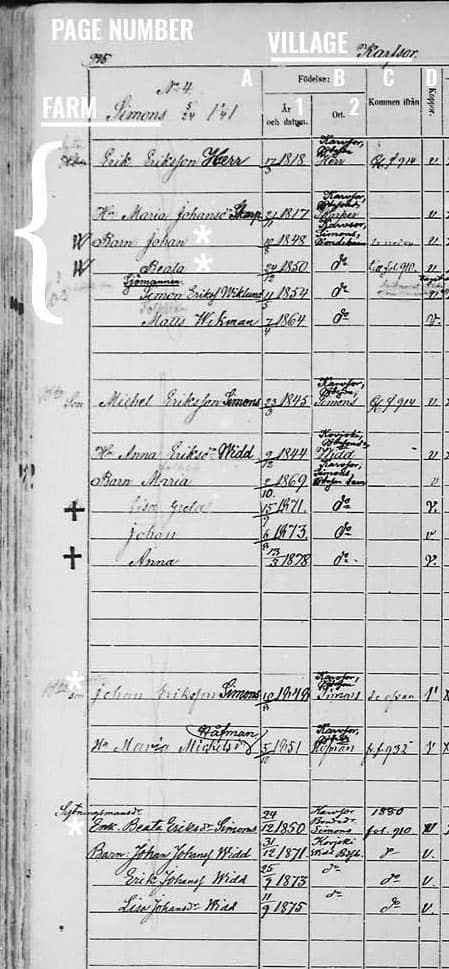 Image provided by Finnish Family History Association.
Image provided by Finnish Family History Association. Column B:2 has the heading Ort, meaning place or locality. This column contains the parishioner’s birthplace. This example is hard to read but it gives both the farm, village, and their position. Erik was born in the village of Karfsor, on the farm Herr, and he was a Bondeson or farmer’s son. Johan was born in the village Karfsor, on the farm Simons, and he was a Bondesbarn or farmer’s child. The remaining children are marked with do which means ditto or same. Generally if the column is blank that means that they were born in the village and farm in which they are currently living. It is also common to see här, or here in English.
Kommen ifrån or Come From—Column C This column records where the family lived before they lived in their current location. It is important to note that this is where they recently moved from, not necessarily where they were born. In our example the record states Gb f.914 on Erik’s line. Gb. is an abbreviation of Gamla bok or old book, the f. is short for folio or page. Erik did not move, there is no check in the margin by his name. The entry tells us the family can be found in the prior communion book on page 914. The abbreviation fb. is sometimes used and is an abbreviation of framför bok or book before this book.
Koppor. or Smallpox—Column D The church kept track if the parishioners had been vaccinated for smallpox.
Läsning or Reading—Column E This section records the results of the household examination. Parishioners were tested on reading ability and spiritual knowledge. It was divided into several parts: E:1 I bok—reading ability, (E:2–E:8 were Utur minnet or from memory), E:2 ABC bok—recite passage from primer E:3 Luth. Cath.—Lutheran catechism E:4 Husaflan.—ten commandments E:5 Spörsmål.—questions E:6 Dav. Ps.—Psalms of David E:7 Bibl historia—Bible history E: 8 Förstår—comprehension or understanding E:9 Vid Läsförhör Tillstädes—present for examination.
Blank—Column F This blank column is used several ways. Our example uses this column to record marriage dates. Some parishes use a specific column for this which usually is headed Vigde. Erik and Maria were married on December 4, 1839.
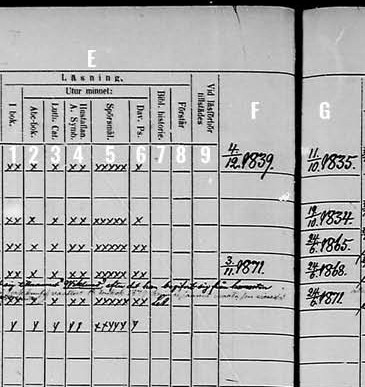 Image provided by Finnish Family History Association.
Image provided by Finnish Family History Association.
Blank—Column G This section usually records if the parishioner has been confirmed. Often the confirmation date will be recorded. This gives you the information you need to look up the confirmation record.
This key will help you to decipher their examination grades. 
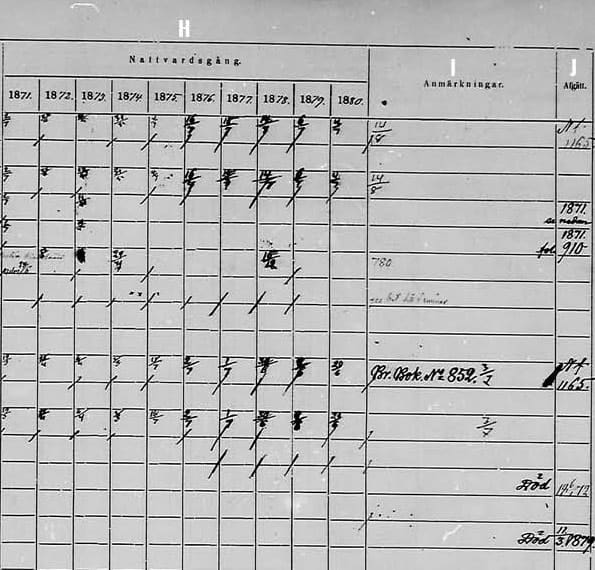 Image provided by Finnish Family History Association.
Image provided by Finnish Family History Association. Nattvardsgång or Holy Communion—Column H This section gives dates that the parishioner received communion in that year. These dated columns can give you clues if your ancestor was living in the parish during those years but a blank column means they were not present for examination.
Anmärkiningar or Remarks—Column I Priest noted information about individual parishioners. These notes could include crimes, reputation, marriages, and much more. This column is very helpful but often requires some translation. Our example has notes recorded for Michel and Beata. Let’s examine the notes for Michel—Br. bok 852 3/1 Br. bok—abbreviation for criminal offense book 853 3/1—where you find the record of the offense in the book This column is crucial for tracing an ancestor that has emigrated. This is where they recorded when a parishioner leaves the country. It often is written like this: till Amerika 1893 or to America 1893.
Afgått or Left—Column J This column tells you where you can find the next record for your ancestor. If they leave the parish their new parish may be recorded or you might find the year they left and the record number for their moving record. If the family is staying put the column will often tell you the page you can find them on in the next volume of communion records. The notation will be listed NB, N.b., or n.b. the abbreviations for nya bok or new book. The new book notation tells you where you can find the whole family but it is usually just written in the head of household’s row. In our example Erik’s row contains Nb. 1165 so we know that we can go to the next communion book and find the family on page 1165. Deaths are also recorded in this column. Our example shows the deaths of two children, Lisa Greta and Anna. Lisa Greta död or died on January 6, 1872 and Anna died on March 17, 1879.